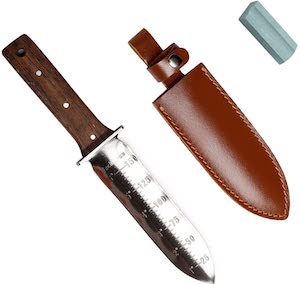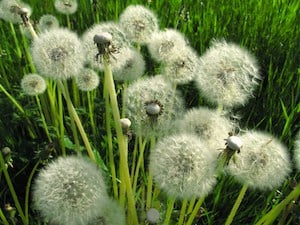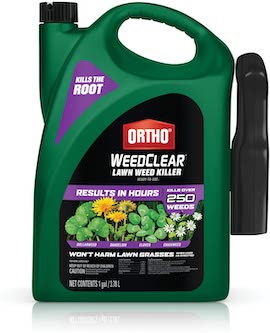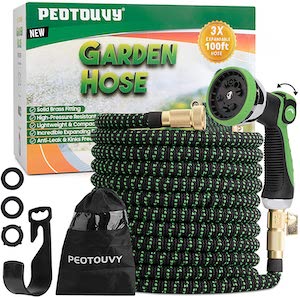Killing Dandelions Without Damaging Your Lawn
Some people love how dandelions look. Children may love to play with them. We have all blown the white fluffy seeds across the grass or stopped to pick a bright yellow flower. But if you are a homeowner, they may be infesting your yard and becoming a nightmare for your lawn.
So, how do you kill dandelions without damaging your lawn? The best way to kill dandelions without damaging your lawn is by pulling them out the old-fashioned way or by using a broadleaf herbicide. While this can be a time-consuming task, your dandelion-free lawn will be well worth the effort.
Dandelions are among the subset of weeds called broadleaf perennials, which are notoriously challenging to remove. Once a dandelion plant has fully established its 10-inch-long taproot, the weed will come back year after year, spreading its spawn across your lawn. That long root is the key to total extermination. If you want to truly rid yourself of a dandelion, you must kill or remove all of the taproots, or the unwanted sprout will come back again with a vengeance.
The fastest, most efficient way to get rid of dandelions is to spray them with a broadleaf herbicide that will kill the entire plant without harming the grass. However, most herbicides you buy at the store are nonselective which means they will kill whatever they touch, including your grass. When you use a herbicide you must be very careful you only apply it to the weed and not to your entire yard. Below we will give instructions for using a broadleaf herbicide as well as pulling by hand.
Pulling Dandelions by Hand – the Natural Way
 Hand pulling dandelions is one of the best ways you can get rid of them. If you do this at the right time of year, you can pull out the whole plant, including the root. Early spring or early fall are the best times of year to clear your yard of dandelions.
Hand pulling dandelions is one of the best ways you can get rid of them. If you do this at the right time of year, you can pull out the whole plant, including the root. Early spring or early fall are the best times of year to clear your yard of dandelions.
In spring, new seedlings won’t have taken hold. In fall, mature plants won’t have the chance to store nutrients in their roots to survive winter frosts. So, when spring comes, any remaining roots should have died, and your yard will be dandelion-free. Pulling these weeds or digging them out is also easier when the soil is wet. You stand a much better chance of removing the whole weed intact. Leaving behind even the smallest part of the taproot can allow the dandelion to grow back.
To hand pull dandelions, try following these steps:
- Water your lawn so the soil is wet, making removal easier.
- Using a dandelion weeding knife or trowel, cut into the soil, down the side of the weed.
- Wiggle the weeder so that the taproot is loosened.
- Using the ground for leverage, lift up the dandelion. It helps to grab the leaves at the base, holding as many of them as you can. This can then be used to pull the taproot out.
- Try to lift the dandelion using an even tension. You don’t want that nasty anchor to snap.
- Hopefully, the dandelion and root will come out intact.
- If it doesn’t, loosen the soil again with your weeder and wiggle it around until it pulls free.
If you decide weeding by hand just isn’t cutting it, you can add a broadleaf herbicide to the blend.
Broadleaf Herbicide for Dandelions
If you’ve opted to use a broadleaf herbicide, you’ll need to do your research and be aware of how the chemicals may affect those around you. You will want to be especially careful if you have pets or children who may be affected. Make sure to read the labels on the bottles carefully and use only as directed.
To use a broadleaf herbicide you will need the following items:
- Watering can
- Weed knife
- Natural weed killer
- Preemergent herbicide
 Step 1: Dig up the Dandelions
Step 1: Dig up the Dandelions
Plants are more easily dug up if the ground is moist. Use the watering can to moisten the ground around the dandelions. Allow a few minutes for the moisture to set in then, gripping the root closest to the ground, try to pull the whole root up with the plant.
Use the weed knife to assist you, working it along the base in two or three places and pushing the soil away from the root by wiggling the knife. Once the root is looser in the soil, pull gently at the base of the plant. If it still feels stuck, work the weed knife down even further and try to get the entire taproot out.

 Step 2: Target and Kill Dandelion Root
Step 2: Target and Kill Dandelion Root
If there is any portion of the dandelion’s taproot remaining, it will grow into a new plant. It is important to kill every last bit of the root so that no new plants emerge. As mentioned previously, most herbicides are nonselective meaning they will kill any plant they touch. Keeping this in mind, carefully apply the herbicide to the hole where the dandelion came out. This way you will kill the root of the dandelion without damaging any of your lawn.
Step 3: Fill in the Hole with Pre-Emergent Herbicide and Soil
There will be an empty spot on your lawn where the dandelions were and you will need to fill in that space so that new weeds do not grow back. Mix the herbicide with soil and fill in the space. It will be unlikely that you will be able to plant grass there since the herbicide is likely nonselective, but hopefully, the rest of your grass will eventually fill in the space. Thankfully filling in this space with pre-emergent herbicide will discourage weeds from coming and filling the space on your lawn.
Step 4: Focus on Your Lawn’s Health
After removing the weeds, it is important to focus on your lawn’s health. A strong and healthy lawn is less vulnerable to weeds and other plants invading it. When your turfgrass is strong, it does not leave much space or nutrients for other weeds to take over.
Follow these lawn maintenance tips to keep your lawn healthy and weed-free:
- Mow high and often. If you keep the grass on your lawn a little higher than usual, it keeps the soil cooler and less optimal for weed growth. Weeds need sunlight to grow so by using the grass to shade the ground makes it less likely that weeds will grow. If you cut your grass too short it’s an invitation for unwanted weeds to invade.
- If weeds have already invaded your lawn, mow your grass often. A weed can’t form seed heads if it keeps getting chopped down.
- Add compost or fertilizer at the right times. Make sure you research the kind of grass you have and give it the correct kind of fertilizer at the right time of year. You want to make sure you are feeding your grass and not your weeds.
- Water your lawn deeply and infrequently. Weeds are just waiting for the right conditions to emerge. They grow best with light, frequent watering.
 Dandelion Removal Solutions that Don’t Work
Dandelion Removal Solutions that Don’t Work
Be careful what advice you follow for getting rid of dandelions. There are some solutions that experts say just don’t work for eliminating dandelions. These solutions make it on to various websites as methods that work, but don’t be fooled, they can be damaging not only for your lawn but for the environment at large! Be careful.
Vinegar
You’ll often hear that dandelions don’t much like vinegar. The acetic acid it contains will indeed damage the leaves and flowers. While this has some limited visual effect, it won’t penetrate the roots. The weed will grow right back.
You’d need to use very strong vinegar to have any real effect, and at the suggested levels (20% acetic acid content) you aren’t really talking about vinegar any more – you’re talking about pouring acid into your garden, which is completely insane and horrible for the environment. Just don’t do it!
Salt
 Salt has some effect in killing plants. The sodium in sodium chloride (salt) is toxic and will get washed around your lawn trying to kill everything it touches. Contrary to what some may lead you to believe, damage to your lawn caused by human error is not covered by your Broken Arrow Home Insurance policy!
Salt has some effect in killing plants. The sodium in sodium chloride (salt) is toxic and will get washed around your lawn trying to kill everything it touches. Contrary to what some may lead you to believe, damage to your lawn caused by human error is not covered by your Broken Arrow Home Insurance policy!
The sodium won’t get decomposed over time – it might go from your lawn to a stream to some farm – all the while damaging any plant it comes into contact with. Please don’t do this! It’s terrible for the environment and not effective on your plants either.
Whether you’ve been battling dandelions for a long time or this is your first time experiencing a lawn full of weeds, there are a lot of resources out there for you to refer to. Make sure you are careful when selecting the kind of herbicide you use and make sure not to just follow trends like using vinegar or salt that can actually do more damage than good for your lawn. It is important to consult with experts when it comes to caring for your lawn so always be willing to get a second opinion.



